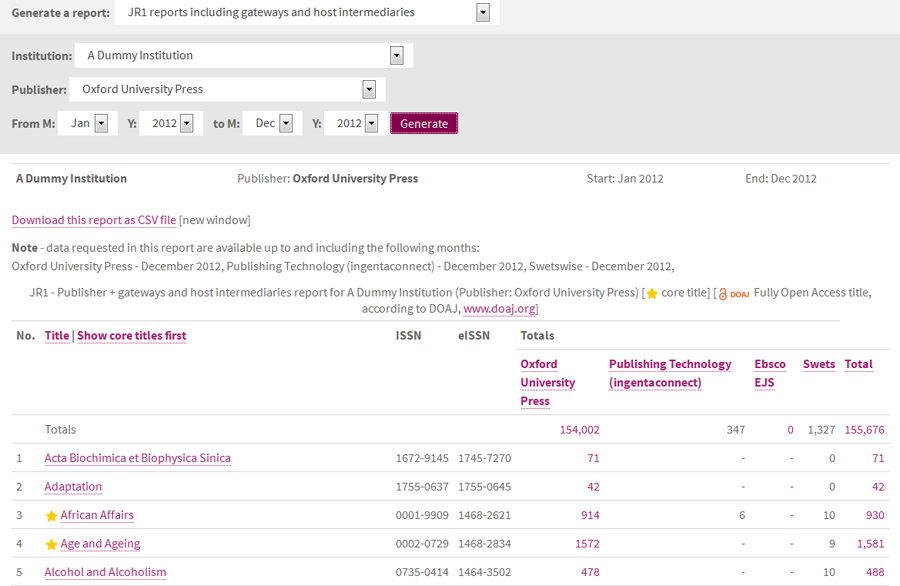JR1 reports including gateways and intermediaries
What it tells you
This report shows you the number of requests for each title from a selected publisher over a selected period of time including accesses via gateways and host intermediaries (ingentaconnect (Publishing Technology), SwetsWise, EbscoHOST, Ebsco EJS and ProQuest).
JUSP presents usage data included in JR1 reports from gateways and host intermediaries alongside usage from the publisher JR1 to give a complete picture of usage. It saves having to add in usage from intermediaries separately on a title by title basis.
How to run the report
- Log in to the portal and go to on Journals (R4)
- Select JR1 reports including gateways and host intermediaries
- Select publisher
- Select date range by month and year
- Click Generate
How to interpret the data
A gateway is an intermediary online service which does not typically host the items requested by the user. SwetsWise and Ebsco EJS are examples of gateway services. Ebsco EJS provided usage statistics up to July 2014; after that date usage of all titles accessed via Ebsco EJS comes directly from the publisher. The SwetsWise service ceased in November 2014.
A host is an intermediary online service which stores items that can be downloaded by the user. Ingentaconnect (Publishing Technology) and EbscoHOST are examples of host services.
Some publishers give direct access to their journals through gateway services and include all usage statistics in their own reports. Other publishers do not record usage through these gateways. All usage through host services is separately recorded, though not all publishers use hosts.
In this table, usage recorded in JR1 reports from gateway and host services is added to that given in the publisher's JR1 report. This enables you to get a complete picture of usage where you use these services.
If all your usage of a particular publisher is through an intermediary service then it will be shown in this report, and the JR1 publisher report will show nil usage. The JR1 reports are likely to contain a number of titles that are not in the deal or collection you subscribe to for various reasons. You are therefore advised to treat the nil usage shown in these reports with some caution.
The JR1 report includes usage of archive or backfile collections which are also recorded in the JR1a report and of GOA (Gold Open Access) articles which are also recorded in the JR1 GOA report.
If you have added details of your core (subscribed) titles, these will be
highlighted by a star in the table. Titles included in the Directory of Open
Access Journals (DOAJ) will also be highlighted with the DOAJ symbol. 
Most summary reports in JUSP include intermediary figures as given in this report, either included in the totals or shown separately. This is always made clear in the notes for each report.
Top tips for using this report
- Sort by title for an alphabetical list, or by total to sort by titles with the highest/lowest number of requests for the publisher, any of the gateways/host intermediaries or for the overall totals
- View your subscribed or core titles as starred items if you have marked them up in the core titles area. Sort your report to see your subscribed or core titles first
- See if there are particular titles that are being used more heavily than others through intermediary services
- Identify DOAJ titles
- Click on individual journal titles to see usage of that title across all years for which data are available including accesses via gateways and host intermediaries and via JSTOR if applicable. JR1a (backfile) and JR1 GOA (Gold Open Access) usage are also displayed
- Download as a CSV file to do your own more detailed analysis in Excel

Related reports
See the report Annual summary use of gateways and host intermediaries to see the percentage of use coming through these routes
